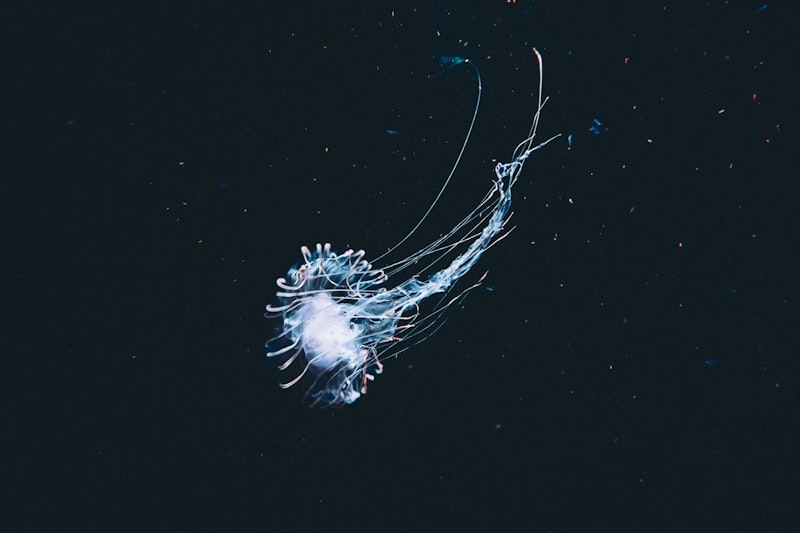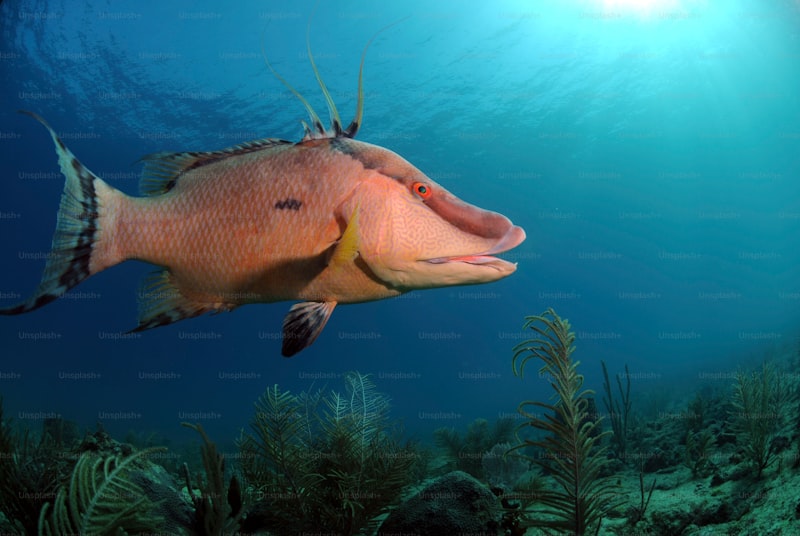One of the most enigmatic creatures of the deep sea is the anglerfish. Known for its bioluminescent lure dangling from its head like a fishing pole, this predator attracts unsuspecting prey in the pitch-black waters. Its grotesque appearance and formidable jaws make it a symbol of the eerie world below.
In these lightless realms, other creatures have also adapted bizarre features to survive. Take the vampire squid, for example. Despite its ominous name, this deep-sea dweller isn’t a bloodthirsty predator but a gentle filter-feeder. Its cloak-like webbing between its tentacles gives it an appearance straight out of a mythical tale.
Yet, not all deep-sea creatures rely on the darkness to conceal themselves. The giant squid, a legendary denizen of the ocean’s depths, occasionally rises to the surface, its massive tentacles and eyes leaving sailors both awe-struck and terrified for centuries. With arms lined with razor-sharp hooks and eyes the size of dinner plates, the giant squid is a testament to nature’s boundless imagination.
The mysteries of the deep sea continue to captivate scientists and explorers alike. From the ethereal jellyfish pulsating with bioluminescence to the bizarre yet mesmerizing gulper eel with its expandable jaws, each creature offers a glimpse into a world where reality surpasses fiction.
As we uncover more about these mysterious creatures, one thing remains certain: the deep sea holds secrets that challenge our understanding of life on Earth. What other marvels lie hidden in its icy blackness, waiting to be discovered? The journey to unraveling these mysteries has only just begun.
Unveiling the Enigma: Deep Sea’s Most Bizarre Creatures
Imagine encountering the anglerfish, a creature straight out of a science fiction tale. Its bioluminescent lure dangles in front of its jaws like a fishing rod, attracting unsuspecting prey in the abyssal depths. This deep-sea predator exemplifies nature’s ingenuity in hunting strategies.

Then there’s the gulper eel, aptly named for its distensible stomach that allows it to swallow prey much larger than itself. Its elongated, snake-like body and large mouth create a striking appearance, perfectly suited for life in the deep where food is scarce and sporadic.
In contrast to the eerie anglerfish and the monstrous gulper eel, the vampire squid presents a more enigmatic figure. Despite its ominous name, it’s a gentle dweller of the deep, using bioluminescent organs called photophores to produce dazzling displays or to escape predators by cloaking itself in darkness.
The fangtooth fish, with its disproportionately large teeth, looks like it belongs in a horror movie. These teeth, however, are more about defense and feeding in the deep-sea environment where every advantage counts in the struggle to survive.
The blobfish, often mischaracterized by its appearance when brought to the surface, is a testament to how life adapts to its surroundings. Its gelatinous body allows it to float effortlessly in the high-pressure environments found thousands of feet below the waves.
Exploring the deep sea is like visiting an alien world, where every species seems more bizarre than the last. From transparent creatures with bioluminescent glow to those with jaw-dropping proportions, these inhabitants remind us of the boundless creativity of evolution in shaping life forms in Earth’s most extreme habitats.
Beyond the Abyss: Strange Beasts That Roam the Deep Sea
Imagine encountering the Goblin Shark, a creature resembling a relic from prehistoric times with its protruding jaw and needle-like teeth. It hunts in the deep with remarkable precision, testament to millions of years of adaptation. Equally eerie is the Anglerfish, a master of camouflage with a bioluminescent lure that attracts unsuspecting prey.
The Viperfish, with its long, needle-like teeth and hinged lower jaw, lurks in the darkness, utilizing its bioluminescent belly to disguise itself from predators below. Another marvel is the Giant Squid, a legendary creature that remains largely elusive, its eyes the size of basketballs, and tentacles armed with powerful suckers.

Among these deep-sea inhabitants, the Gulper Eel stands out with its expandable jaw, capable of swallowing prey much larger than itself. Its slender body and large mouth make it a formidable predator in the abyssal plains. Equally fascinating is the Vampire Squid, which, despite its ominous name, feeds primarily on marine snow and detritus, using its webbed arms to drift effortlessly in the currents.
The deep sea remains a realm largely unexplored, holding secrets and species yet to be discovered. Each creature adapted uniquely to survive in an environment where temperatures are near freezing and pressures can crush submarines. Exploring “Beyond the Abyss: Strange Beasts That Roam the Deep Sea” unveils a world where reality often exceeds fiction, where evolution has crafted beings as bizarre as they are resilient, shaping a realm that continues to astound and intrigue scientists and enthusiasts alike.
Secrets of the Abyss: Discovering the Unknown Deep Sea Creatures
Imagine encountering the anglerfish, a master of deception with its bioluminescent lure dangling in front of its terrifying mouth. This creature embodies both beauty and danger, showcasing nature’s incredible adaptability to survive in extreme conditions.
Moving deeper into the abyss, we meet the gulper eel, an eerie creature with a massive mouth that can swallow prey much larger than itself. Its long, serpent-like body is a testament to the bizarre adaptations that evolve in the deep-sea darkness.
Among the most mesmerizing discoveries is the vampire squid, not a true squid nor an octopus, but a unique creature that pulsates with otherworldly bioluminescence. It uses this light to create dazzling displays or to vanish into the darkness, evading predators in a spectacular fashion.
Further exploring, we encounter the barreleye fish, with its transparent head revealing its upward-looking eyes. This adaptation allows it to see prey silhouetted against the faint light filtering from above, a strategy that helps it thrive in the perpetual darkness of the deep sea.
The mysteries of the abyss continue to unfold with each exploration, revealing creatures that challenge our understanding of life on Earth. These deep-sea marvels, adapted to pressures and conditions unimaginable to us surface dwellers, remind us of the boundless diversity and resilience of nature beneath the waves.
Journey into Darkness: Exploring the Mysteries of Deep Sea Fauna
Imagine plunging into the abyss, where sunlight barely penetrates, and encountering creatures unlike anything seen on land. Among them are the anglerfish, with its bioluminescent lure dangling above its monstrous jaws, enticing prey in the inky blackness. It’s a scene straight out of a sci-fi thriller, yet it’s real and thriving thousands of feet below.
One of the most astonishing deep-sea dwellers is the vampire squid. Despite its ominous name, this creature is more of a gentle ghost, using bioluminescent organs to create dazzling displays or cloak itself in darkness, avoiding predators. Its existence raises questions about adaptation and survival in extreme environments.
The gulper eel, another denizen of the deep, sports a mouth that can engulf prey much larger than itself, illustrating the fierce competition for food in these harsh conditions. Meanwhile, the blobfish, with its gelatinous appearance, defies conventional notions of beauty but perfectly suits its habitat’s crushing pressures.
These creatures, adapted to an environment where few others can survive, highlight the ingenuity of evolution. They challenge our understanding of life’s limits and expand our appreciation for the diversity of ecosystems on our planet. Their adaptations—bioluminescence, extreme pressure tolerance, and unique body shapes—serve as blueprints for innovation in fields ranging from medicine to materials science.
Aliens of the Deep: The Weird and Wonderful Creatures Below
Imagine a world where glowing jellyfish drift like ethereal ghosts through the midnight abyss, their bioluminescence painting the darkness with an otherworldly glow. These creatures, known as comb jellies, propel themselves with shimmering rows of cilia, creating a hypnotic dance in the water.
Venture deeper, where the pressure could crush a submarine, and you’ll encounter the vampire squid. Despite its ominous name, this creature is a gentle inhabitant of the deep, using bioluminescent organs called photophores to produce flashes of light, confusing predators or potential prey.
But perhaps the strangest of them all is the blobfish, a creature so peculiar-looking that it appears more like a gelatinous mass than a fish. Found off the coasts of Australia and New Zealand, this deep-sea dweller lacks muscles and relies on its gelatinous structure to stay buoyant in the crushing depths.
Then there’s the gulper eel, aptly named for its enormous, hinged jaw that allows it to swallow prey much larger than itself. Its long, slender body and expandable stomach make it a formidable predator in the dark depths where food is scarce and survival is a constant battle.
In this alien world beneath the waves, survival often means adaptation to extreme conditions. Take the anglerfish, for instance, with its bioluminescent lure dangling in front of its jaws like a fishing pole, attracting unsuspecting prey in the eternal darkness.
These creatures are not just marvels of nature; they are reminders of how little we truly know about our own planet. Each one holds secrets that could unlock new insights into evolution, adaptation, and the resilience of life in even the most hostile environments.
So next time you gaze out over the ocean, remember that beneath the surface lies a world of wonders waiting to be discovered. From the eerie glow of bioluminescence to the alien forms of deep-sea life, our oceans are teeming with mysteries that continue to intrigue and inspire us all.
Hidden Horrors: Mysterious Deep Sea Monsters Revealed
One of the most chilling discoveries is the Fangtooth Fish, aptly named for its long, needle-like teeth that protrude eerily from its mouth. This creature thrives in the deepest parts of the ocean, adapting to survive under immense pressure and scarce food sources. Its appearance alone invokes a primal fear, as if it’s a relic from a prehistoric era.
Moving deeper into the abyss, the Giant Squid emerges as a legendary creature that has fascinated sailors and scientists alike for centuries. With eyes the size of dinner plates and tentacles that can span up to 40 feet, this colossal cephalopod embodies the mysteries of the deep. Its existence was once considered mythical until specimens were finally captured on camera in their natural habitat.
But perhaps the most chilling of all is the Goblin Shark, often referred to as a living fossil due to its ancient lineage. This shark prowls the ocean floor with its distinctive, blade-like snout and extendable jaws that snap shut like a trap. Its ghostly appearance and elusive nature have earned it a reputation as a true deep-sea terror.
As we uncover these mysterious creatures, one thing becomes clear: the ocean’s depths hold secrets that challenge our understanding of life on Earth. Each of these deep-sea monsters reminds us of the boundless wonders and hidden horrors that await beneath the waves.
Frequently Asked Questions
What role do deep-sea creatures play in the marine ecosystem?
Deep-sea creatures play crucial roles in the marine ecosystem by contributing to nutrient cycling, controlling populations of other organisms, and providing a food source for higher predators. Their adaptations to extreme pressures and cold temperatures also offer insights into biological resilience and potential applications in medicine and technology.
Why are deep-sea creatures often bioluminescent?
Deep-sea creatures are often bioluminescent to adapt to their dark environment. Bioluminescence helps them attract prey, camouflage themselves, and communicate in the absence of light.
What are some examples of mysterious creatures found in the deep sea?
Discover fascinating examples of mysterious creatures found in the deep sea, from the elusive anglerfish with its bioluminescent lure to the ghostly gulper eel known for its enormous mouth. These creatures adapt to extreme depths, showcasing unique adaptations that continue to intrigue scientists and ocean enthusiasts alike.
How do deep-sea creatures adapt to extreme pressure and darkness?
Learn how deep-sea creatures adapt to survive extreme pressure and darkness, exploring their unique physiological and behavioral adaptations.
How do scientists study and explore mysterious deep-sea creatures?
Learn how scientists explore and study mysterious deep-sea creatures through specialized submersibles and remotely operated vehicles equipped with cameras and sampling tools. They analyze biological samples and footage to understand adaptations to extreme pressure and darkness, revealing unique insights into these elusive marine environments.


